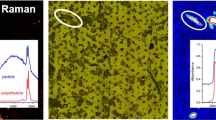Abstract
Very limited information is available on the impacts of organic farming practices on the chemical composition and properties of dairy manure. In this study, we found the differences in the absorptivities of dissolved organic matter between conventional and organic dairy manure samples at 254 and 280 nm, reflecting the difference in aromaticities of dissolved organic matter of the manures. The 13C nuclear magnetic resonance (NMR) characteristics of triple peaks around 30 ppm were more evident in organic samples than in conventional dairy manure samples. This observation was presumably due to more forage feedstuff used in organic dairy farms as this spectral feature was assigned to cutin and cutan from the outer cuticle of herbaceous plants. Thus, the distinct NMR feature of manure around 30 ppm, if further confirmed, can serve as a traceable forage marker to evaluate the authenticity of organic dairy farming programs.


Similar content being viewed by others
References
Chefetz B, Salloum MJ, Deshmukh AP, Hatcher PG (2002) Structural components of humic acids as determined by chemical modifications and carbon-13 NMR, pyrolysis-, thermochemolysis-gas chromatography/mass spectrometry. Soil Sci Soc Am J 66:1159–1171
Dixon WT (1982) Spinning-sideband-free and spinning-sideband-only NMR spectra in spinning samples. J Chem Phys 77:1800–1809
He Z (Ed.) (2011) Environmental chemistry of animal manure. Nova Science Publishers, NY. 459 pp
He Z, Mao J (2011) Functional groups identified by solid state 13C NMR spectroscopy. In: He Z (ed) Environmental chemistry of animal manure. Nova, NY, pp 41–59
He Z, Ohno T (2012) Fourier transform infrared and fluorescence spectral features of organic matter in conventional and organic dairy manure. J Environ Qual 41:911–919
He Z, Wang JJ (2012) Characterization of plant nutrients and traceable marker components in dairy manure for organic dairy farming management evaluation. In: He Z (ed) Applied research of animal manure: challenges and opportunities beyond the adverse environmental concerns. Nova, New York, pp 3–19
He Z, Honeycutt CW, Griffin TS (2003) Comparative investigation of sequentially extracted P fractions in a sandy loam soil and a swine manure. Commun Soil Sci Plant Anal 34:1729–1742
He Z, Mao J, Honeycutt CW, Ohno T, Hunt JF, Cade-Menun BJ (2009) Characterization of plant-derived water extractable organic matter by multiple spectroscopic techniques. Biol Fertil Soil 45:609–616
He Z, Cao X, Mao J, Ohno T, Waldrip HM (2013) Analysis of carbon functional groups in mobile humic acid and recalcitrant humate extracted from eight US soils. Pedosphere 23:705–716
Hunt JF, Ohno T, He Z, Honeycutt CW, Dail DB (2007a) Influence of decomposition on chemical properties of plant- and manure-derived dissolved organic matter and sorption to goethite. J Environ Qual 36:135–143
Hunt JF, Ohno T, He Z, Honeycutt CW, Dail DB (2007b) Inhibition of phosphorus sorption to goethite, gibbsite, kaolin by fresh and decomposed organic matter. Biol Fertil Soil 44:277–288
Luo Y, Zhang D, Yu G, Shen Q (2013) Aromatic moieties from matured chicken manure and agriculture residues compost suppress growth of Lepidium sativum L. and Trichoderma harzianum. Pedosphere 23:826–834
Mao J, Olk DC, Fang X, He Z, Bass J, Schmidt-Rohr K (2008) Influence of animal manure application on the chemical structures of soil organic matter as investigated by advanced solid-state NMR and FT-IR. Geochemistry 146:353–362
Novak SM, Fiorelli JL (2010) Greenhouse gases and ammonia emissions from organic mixed crop-dairy systems: a critical review of mitigation options. Agron Sustain Dev 30:215–236
Patel M, Wredle E, Sporndly E, Bertilsson J, Kumm K-I (2013) Profitability of organic and conventional dairy production with different dietary proportions of high-quality grass silage. Org Agr 3:31–39
Sato K, Bartlett PC, Erskine RJ, Kaneene JB (2005) A comparison of production and management between Wisconsin organic and conventional dairy herds. Livest Prod Sci 93:105–115
Schnitzer MI, Monreal CM, Facey GA, Fransham PB (2007) The conversion of chicken manure to biooil by fast pyrolysis I. Analyses of chicken manure, biooils and char by 13C and 1H NMR and FTIR spectrophotometry. J Environ Sci Health, Part B 42:71–77
Schori F, Munger A (2014) Intake, feed conversion efficiency and grazing behaviour of two Holstein cow strains in a pasture-based production system under organic farming in Switzerland. Org Agr. doi:10.1007/s13165-014-0066-2
Shao ZH, He PJ, Zhang DQ, Shao LM (2009) Characterization of water-extractable organic matter during the biostabilization of municipal solid waste. J Hazard Mater 164:1191–1197
Shechter M, Xing B, Chefetz B (2010) Cutin and cutan biopolymers: their role as natural sorbents. Soil Sci Soc Am J 74:1139–1146
USDA (2011) Organic production and handling standards. United States Department of Agriculture. Washington D.C. Available at: http://www.ams.usda.gov/AMSv1.0/getfile?dDocName=STELDEV3004445. Accessed: 02 Dec (2013)
Weishaar JL, Aiken GR, Bergamaschi BA, Fram MS, Fujii R, Mopper K (2003) Evaluation of specific ultraviolet absorbance as an indicator of the chemical composition and reactivity of dissolved organic carbon. Environ Sci Technol 37:4702–4708
Zhang M, He Z, Zhao A (2011) Ultraviolet-visible absorptive features of water extractable and humic fractions of animal manure and relevant compost. In: He Z (ed) Environmental chemistry of animal manure. Nova, NY, pp 61–81
Author information
Authors and Affiliations
Corresponding author
Additional information
Mention of trade names or commercial products in this publication is solely for the purpose of providing specific information and does not imply recommendation or endorsement by the US Department of Agriculture. USDA is an equal opportunity provider and employer.
Rights and permissions
About this article
Cite this article
He, Z., Zhang, M., Cao, X. et al. Potential traceable markers of organic matter in organic and conventional dairy manure using ultraviolet–visible and solid-state 13C nuclear magnetic resonance spectroscopy. Org. Agr. 5, 113–122 (2015). https://doi.org/10.1007/s13165-014-0092-0
Received:
Accepted:
Published:
Issue Date:
DOI: https://doi.org/10.1007/s13165-014-0092-0




